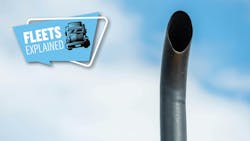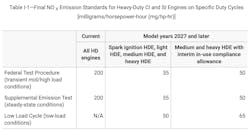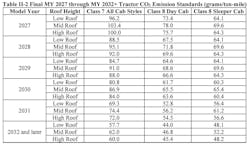Key takeaways
- The Clean Air Act empowers EPA and CARB to set emissions standards, but recent political shifts threaten to weaken these regulations.
- Recent EPA rules tighten emissions standards for heavy-duty engines from MY2027 onward, but these are under review by the current administration.
- California's waivers to set standards have been challenged and revoked, impacting states that follow CARB regulations.
- Legal battles and policy debates are ongoing, with more regulatory changes to come.
The transportation sector is a major source of harmful emissions. The sector—including trucking, rail, shipping, and light-duty operations—is the largest source of U.S. greenhouse gas emissions, contributing 28.5% of total GHG emissions, according to the U.S. EPA’s 2023 inventory. Within transportation, heavy-duty vehicles contribute about 23% of the sector’s GHG emissions.
Heavy-duty vehicle emission regulations fall under two major authorities: the U.S. Environmental Protection Agency and the California Air Resources Board. These authorities have shaped the heavy-duty vehicle market for over 50 years and continue to do so. However, the regulatory landscape is changing fast.
Enforcing the Clean Air Act, these authorities require manufacturers' vehicles to meet specific (and sometimes expensive) emissions standards. The federal government's new president and Congressional makeup, however, seem determined to dial down the industry's emissions rules.
This is part of FleetOwner's Fleets Explained, a Trucking 101 series to break down aspects of the trucking and fleet management industries. You can read more from the series, launched in May 2024, at fleetowner.com/fleets-explained. To submit topic ideas, clarifications, and corrections, email [email protected].
What is the Clean Air Act?
The 1970 Clean Air Act is the foundation of federal air quality law. It regulates air emissions from stationary or mobile sources and allows the EPA to establish emissions standards.
Under the authority of the Clean Air Act, EPA can prescribe standards for any air pollutant from any motor vehicle that could reasonably endanger public health. EPA regularly makes new rules to better regulate motor vehicle emissions, including particulate matter, nitrogen oxides (NOx), carbon monoxide, and miscellaneous air toxins.
For trucking, EPA regulates original equipment manufacturers (OEMs). These OEMs must undergo testing and certification to ensure the equipment they sell meets emission requirements. However, manufacturers have occasionally tried to bypass the rules. Emissions fraud can cost manufacturers more than a billion dollars, exemplified by Hino's recent $1.6 billion settlement.
One of EPA’s latest major emission regulations is “Control of Air Pollution From New Motor Vehicles: Heavy-Duty Engine and Vehicle Standards.” The final rule adopted by EPA in December 2022 introduces many requirements. Notably, it tightens nitrogen oxides, particulate matter, carbon monoxide, and hydrocarbon emission standards in heavy-duty engines for model year 2027 and beyond. The rule is also known as Heavy-Duty NOx—and it could soon be changed by the new administration.
See also: Fleets Explained: DEF and NOx
EPA’s other recent major emission regulation focuses on greenhouse gases.
How does the Clean Air Act regulate greenhouse gases?
It wasn’t always the case, but currently the Clean Air Act requires the EPA to regulate emissions of greenhouse gases (this will likely be changed—more information below).
This requirement became official following the 2007 Supreme Court decision in Massachusetts v. EPA. In its decision, the Court ruled that greenhouse gases—gases that affect Earth’s atmosphere and contribute to climate change—are air pollutants, and thus EPA can and must regulate vehicles producing those gases under the Clean Air Act.
In 2009, the EPA formally recognized that six primary greenhouse gases, including carbon dioxide, threaten public health. Since then, EPA has published several rules to regulate greenhouse gas emissions.
EPA’s latest major greenhouse gas rulemaking is “Final Rule: Greenhouse Gas Emissions Standards for Heavy-Duty Vehicles – Phase 3.” Adopted as a final rule in March 2024, the standard introduces tightening carbon dioxide emission standards for heavy-duty vehicles from Model Year 2027 through 2032 and beyond. Critics call the regulation an EV mandate, though that is a misconception.
The emission standard varies by equipment type and model year, ranging from 103.4 grams per ton-mile for MY2027 high roof Class 7 tractors to 45.4 g/t-m for MY2032 high roof Class 8 day cab tractors.
What is CARB, and how does it regulate trucking?
EPA is not the only major regulatory authority for vehicle emissions. The California Air Resources Board sets emissions standards for California. Other states have the option to adopt CARB’s standards.
The Clean Air Act prohibits states from setting their own emission standards—but with one key exception. The Clean Air Act allows states with pre-existing emissions standards to seek a waiver to set their own emissions standards. California was the only state with existing emissions standards before the Clean Air Act, due to the state’s severe air quality problems.
Los Angeles established the first air pollution control program in the nation in 1947. In 1959, the state legislature founded the California Motor Vehicle Pollution Control Board, which regulated vehicle emissions and would later become the California Air Resources Board. The Board established the first tailpipe emissions standards in the nation in 1966.
The federal government consistently granted California’s emissions waivers since the passage of the Clean Air Act until recently. In 2009, after EPA recognized the public health threat posed by greenhouse gases, the agency granted California a waiver to regulate vehicles’ greenhouse gas emissions.
Other states have the option to adopt California’s emissions standards without asking for authorization. These states are sometimes called CARB states.
Federal lawmakers knock down CARB regulations
Until this year, the biggest CARB regulations affecting heavy-duty vehicles were Heavy-Duty Omnibus, which established strict engine emissions standards, and Advanced Clean Trucks, which introduced a zero-emissions vehicle sales requirement. In June, Congress and the president used the Congressional Review Act to revoke the EPA waivers that authorized CARB's Omnibus and ACT regulations.
Emissions standards will likely weaken under Trump
This explainer article will change over time. The Trump administration intends to roll back EPA's standards and revoke CARB's regulatory autonomy.
Since November 2024, the trucking industry has expected the Trump administration to combat emissions regulations in favor of a weaker regulatory landscape. Industry groups tend to prefer this outcome: Emissions standards benefit public health but also raise fleet equipment costs.
EPA is working to weaken vehicle emissions rules
In March, EPA Administrator Lee Zeldin announced the agency would "reconsider" its emissions standards. Zeldin made clear that he means to replace GHG3, heavy-duty NOx, and beyond with more business-friendly rules.
EPA in July proposed to revoke the 2009 endangerment finding and all regulations that depend on it. If the agency can remove the endangerment finding, it could nullify all of EPA's GHG emissions standards.
It is unclear how far or how quickly the rollback could occur. Jim Mullen, an industry leader familiar with the first Trump administration, said he expects EPA to revert to GHG Phase 2 standards for a year or more. Manufacturers have expressed hope that EPA would either delay the NOx rule or weaken its waiver requirements.
Legal battles further muddy regulatory outlook
The Trump administration's emissions rule rollback is pursuing—and defending—several legal battles with uncertain fates. Some legal experts expect battles to travel all the way to the Supreme Court.
- California is contesting its waiver revocations, arguing that the Congressional Review Act does not apply to these waivers.
- The Department of Justice is pressuring manufacturers to leave the Clean Truck Partnership, and manufacturers in turn sued California to exit the partnership.
- Revoking the endangerment finding has steep bureaucratic requirements and would almost certainly provoke further lawsuits
About the Author
Jeremy Wolfe
Editor
Editor Jeremy Wolfe joined the FleetOwner team in February 2024. He graduated from the University of Wisconsin-Stevens Point with majors in English and Philosophy. He previously served as Editor for Endeavor Business Media's Water Group publications.




